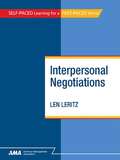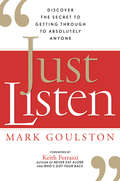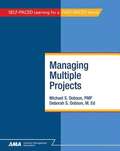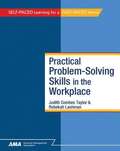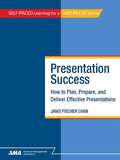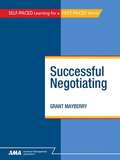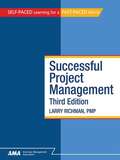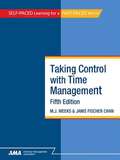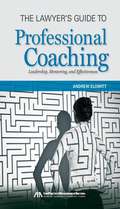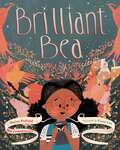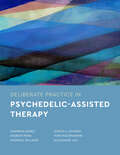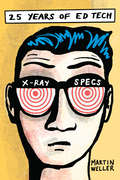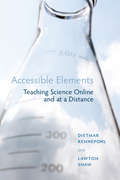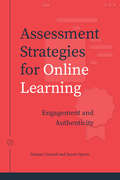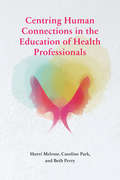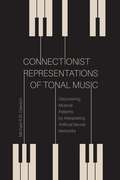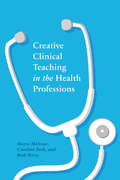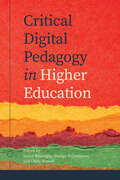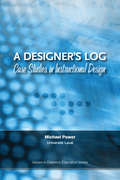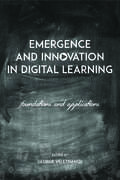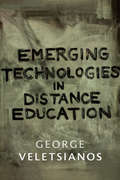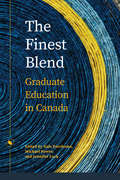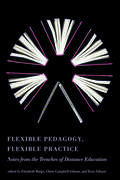- Table View
- List View
Interpersonal Negotiations Breaking Down the Barriers
by Len LeritzFinally…a negotiation framework that encourages a positive outcome for both parties. This book takes the "win/win" concept a step further to make negotiating a more gratifying experience—even if you don’t get exactly what you want. Interpersonal Negotiations: Breaking Down the Barriers builds on mutual understanding and respect for each other's needs and provides a proven framework for fulfilling them. You’ll discover the secrets that can help turn an adversary into an advocate. You will learn how to: • Ensure a safe, fair, and effective negotiation process • Direct the negotiation process to create mutual understanding and acceptance • Recognize and understand your own needs and those of the other person • Make it easy for others to understand your needs • Be creative and persistent to address and resolve blocks to successful negotiation • Assess the other person's behavioral and emotional responses • Acknowledge your own and the other person's perceptions and beliefs • Avoid getting mired in the process
Just Listen
by Thierry GroensteenThe first make-or-break step in persuading anyone to do any thing is getting them to hear you out. Whether the person is a harried colleague, a stressed-out client, or an insecure spouse, things will go from bad to worse if you can't break through emotional barricades. Drawing on his experience as a psychiatrist, business consultant, and coach, and backed by the latest scientific research, author Mark Goulston shares simple but power ful techniques readers can use to really get through to people--whether they're coworkers, friends, strangers, or enemies. Getting through is a fine art but a critical one. With the help of this groundbreaking book readers will be able to turn the "impossible" and "unreachable" people in their lives into allies, devoted customers, loyal colleagues, and lifetime friends.
Managing Multiple Projects
by Michael S. Dobson Deborah S. DobsonLet’s face it — who among us has only a single project? Multiple projects are the norm, not the exception, and there are very good reasons why this is so. A lot of projects simply aren’t big enough to justify the investment of a full-time project manager: having only one is impractical. Depending on the availability of resources, a multiple project environment can accomplish substantial work while lowering the overhead burden of project management by consolidating processes. In this book, you will learn how to recognize the characteristics and to manage effectively in each of these situations, how to plan and organize your work, how to influence other people who may not report to you in an official supervisory capacity, and how to get results. This is an ebook version of the AMA Self-Study course. If you want to take the course for credit you need to either purchase a hard copy of the course through amaselfstudy.org or purchase an online version of the course through www.flexstudy.com.
Practical Problem-Solving Skills in the Workplace
by Judith Combes Taylor Rebekah LashmanProblem-solving skills to identify and resolve work-related problems and improve job performance. With the increasing emphasis on initiative in the workplace, it‘s essential to know how to recognize, define, and analyze problems and then develop workable solutions to correct them. This book provides all the skills needed to achieve this, including a problem-solving tree. Readers will learn how to: • Evaluate your own problem-solving strengths and weaknesses • Use problem-solving skills to identify and resolve work-related problems and improve your job performance • Track the steps you need to solve work-related problems with the Problem-Solving Tree. This is an ebook version of the AMA Self-Study course. If you want to take the course for credit you need to either purchase a hard copy of the course through amaselfstudy.org or purchase an online version of the course through www.flexstudy.com.
Presentation Success: How to Plan, Prepare, and Deliver Effective Presentations
by Janis Fischer ChanWhat does it take to impress an audience? No more boring presentations! Presentation Success gives you what it takes to succeed—spectacularly—when you stand up to impress an audience. Packed with easy-to-use worksheets, strategies, and tips, this book delivers success. It helps you overcome "presentation fear" and makes it easy to plan, prepare, and deliver the kind of presentations that make people sit up and take notice. You’ll discover the best ways to prepare your opening, write smooth transitions, plan your Q&A session, and troubleshoot potential problem areas. You’ll learn how to use body language, communicate clearly, gain and hold attention, listen effectively, and elicit valuable feedback. Eye-opening self-evaluation exercises enable you to pull the pieces together and practice the skills you need to be a resounding success. You can use the handy resource section to access timely books, websites, and media tools to continue your learning.
Successful Negotiating
by Grant MayberryHow to achieve positive outcomes using planning and conversational techniques. Very few of us are born negotiators. However, Successful Negotiating can teach you the art of win/win negotiation. You’ll get a firm grasp of the negotiating tricks and techniques the pros use. Learn everything from prenegotiation planning to the use of seemingly unimportant details like seating arrangements and meeting site selection to influence the results of negotiations. You will learn how to: • Sway an opponent with timing and association techniques • Identify an opponent's real but often hidden needs • Use questions to control the thrust of a discussion • Employ proven strategies like the "missing man," "straw issues," and "walkout" ploys • Communicate a position clearly and precisely • Plan a realistic course of action based on sound preparation and an objective appraisal of resources • Keep the negotiation process open to reasonableness and flexibility at all times • Draw on your own skills, experience, and self-discipline to keep the process moving in the direction you want
Successful Project Management, Third Edition
by Larry RichmanSuccessful Project Management, Third Edition, covers the fundamentals of project management, focusing on practical skills you can apply immediately to complete projects on time, on budget, and on target! This book teaches you how to use proven strategies in large or small projects to clarify the objectives, avoid serious errors of omission, and eliminate costly mistakes. Gain the skills to: • Set measurable project objectives and create a practical plan to achieve them. • Manage the time, cost, and scope of the project. • Lead the project team and manage relationships effectively and productively across the spectrum of project stakeholders. Modern project management is a premier solution in business and nonprofit organizations. Project managers find success using a structured approach to project planning, scheduling, resourcing, decision making, and management. This book isn’t just for project managers. Team members need to know how to carry out their part of the project, and business executives need to understand how they must support project management efforts in the organization. Now you can master the skills and techniques you need to bring projects in on schedule, and on budget, with Successful Project Management. No matter how complex or extensive your project, you’ll understand how to exercise the strict planning, tracking, monitoring, and management techniques needed to stay on top of every project.
Taking Control with Time Management
by M. J. Weeks Janis Fisher ChanHow to balance the demands of work and personal life. Apply the tools and techniques in this book to meet contemporary time challenges and balance the demands of work and personal life. Now packed with exercises and application tools, this up-to-the-minute revision of the classic gives you proven time management strategies to increase your productivity and your efficiency. You�ll discover how to use effective systems for setting and achieving your goals and reducing on-the-job stress. You will learn how to: � Conduct a personal time audit � Conquer time wasters, including pitfalls of e-mail, cell phones, and the Internet � Delegate appropriately and effectively � Set SMART goals and establish priorities � Uncover the time you need for planning, supervising, and decision making � Manage information overload and avoid �wired stress� � Schedule and conduct well-run meetings that focus on effective actions and goals � Maximize the returns on your telephone, travel, and meeting times � Use team time more productively � Set up and implement a Time Management Plan � Make changes that will reduce stress and add balance to your life
The Busy Lawyer's Guide to Success: Essential Tips to Power Your Practice
by Reid F. Trautz Dan PinningtonBusy lawyers do not have dozens of extra hours to conduct research looking for new tips and ideas to streamline and enhance their practice of law. They need just-in-time learning to acquire the knowledge necessary to build their practices. This convenient pocket guide is the best ever collection of practical tips, ideas, and techniques to help you survive, thrive, and find success in the practice of law.
The Lawyer's Guide to Professional Coaching: Leadership, Mentoring, and Effectiveness
by Andrew ElowittBecome more efficient and profitable in your law practice by employing a professional coach. The Lawyer's Guide to Professional Coaching will teach you to find, select, and work productively with the right coach for your needs--and transform your practice in the process. Learn how to get the most out of coaching, decide whether coaching is right for you and your firm, and use coaching skills when you collaborate with clients and colleagues.
Microsoft® OneNote In One Hour for Lawyers
by Ben M. SchorrEach copy of Microsoft® Office 2010 sold now includes OneNote, and its usage among lawyers is poised to skyrocket. With this guide, learn to use OneNote in your law practice to save time and increase productivity. Microsoft® OneNote in One Hour for Lawyers will explain, in plain English, how to get started with the software, develop best practices, and become far more effective in your note-taking and research.
Brilliant Bea: A Story for Kids With Dyslexia and Learning Differences
by Shaina Rudolph Mary VukadinovichAn endearing and empowering story that demonstrates that a learning difference like dyslexia doesn&’t define who you are. Despite her struggles with reading and writing, Beatrice is a natural and brilliant storyteller. With the help of a kind-hearted teacher, Beatrice uses an old-fashioned tape recorder so she can speak her words and then play them back, as a technique for learning in whole new way. With her new approach, Beatrice is able to show her classmates who she really has been all along. This book is set in EasyReading, a dyslexia-friendly font.
Deliberate Practice in Psychedelic-Assisted Therapy (Essentials of Deliberate Practice Series)
by Shannon Dames Andrew Penn Monnica Williams Joseph Zamaria Tony Rousmaniere Alexandre VazDeliberate practice exercises help trainees learn and apply psychedelic-assisted psychotherapy skills while honing their own personalized approach.
25 Years of Ed Tech (Issues in Distance Education)
by Martin WellerIn this lively and approachable volume based on his popular blog series, Martin Weller demonstrates a rich history of innovation and effective implementation of ed tech across higher education. From Bulletin Board Systems to blockchain, Weller follows the trajectory of education by focusing each chapter on a technology, theory, or concept that has influenced each year since 1994. Calling for both caution and enthusiasm, Weller advocates for a critical and research-based approach to new technologies, particularly in light of disinformation, the impact of social media on politics, and data surveillance trends. A concise and necessary retrospective, this book will be valuable to educators, ed tech practitioners, and higher education administrators, as well as students.
Assessment Strategies for Online Learning: Engagement and Authenticity (Issues in Distance Education)
by Dianne Conrad Jason OpenoFor many learners assessment conjures up visions of red pens scrawling percentages in the top right-hand corner of exams and feelings of stress, inadequacy, and failure. Although negative student reactions to evaluation have been noted, assessment has provided educational institutions with important information about learning outcomes and the quality of education for many decades. But how accurate is this data and has it informed practice or been fully incorporated into the learning cycle? Conrad and Open argue that the potential in many of the new learning environments to alter and improve assesment has yet to be explored by educators and students. In their investigation of assessment methods and learning approaches, Conrad and Openo aim to explore assessment that engages learners and authentically evaluates education. They insist that moving to new learning environments, specifically those online and at a distance, afford educators opportunities to embrace only the most effective face-to-face assessment methods and to realize the potential of delivering education in the digital age. In this volume practitioners will find not only an indispensable introduction to new forms of assessment but also a number of best practices as described by experienced educators.
Centring Human Connections in the Education of Health Professionals
by Sherri Melrose Caroline Park Beth PerryMany of today’s learning environments are dominated by technology or procedure-driven approaches that leave learners feeling alone and disconnected. The authors of Centring Human Connections in the Education of Health Professionals argue that educational processes in the health disciplines should model, integrate, and celebrate human connections because it is these connections that will foster the development of competent and caring health professionals. Centring Human Connections in the Education of Health Professionals equips educators working in clinical, classroom, and online settings with a variety of teaching strategies that facilitate essential human connections. Included is an overview of the educational theory that grounds the authors’ thinking, enabling the educators who employ the strategies included in the book to assess their fit within curriculum requirements and personal teaching philosophies and understand how and why they work.
Connectionist Representations of Tonal Music: Discovering Musical Patterns by Interpreting Artifical Neural Networks
by Michael R. DawsonPreviously, artificial neural networks have been used to capture only the informal properties of music. However, cognitive scientist Michael Dawson found that by training artificial neural networks to make basic judgments concerning tonal music, such as identifying the tonic of a scale or the quality of a musical chord, the networks revealed formal musical properties that differ dramatically from those typically presented in music theory. For example, where Western music theory identifies twelve distinct notes or pitch-classes, trained artificial neural networks treat notes as if they belong to only three or four pitch-classes, a wildly different interpretation of the components of tonal music. Intended to introduce readers to the use of artificial neural networks in the study of music, this volume contains numerous case studies and research findings that address problems related to identifying scales, keys, classifying musical chords, and learning jazz chord progressions. A detailed analysis of the internal structure of trained networks could yield important contributions to the field of music cognition.
Creative Clinical Teaching in the Health Professions
by Sherri Melrose Caroline Park Beth PerryFor healthcare professionals, clinical education is foundational to the learning process. However, balancing safe patient care with supportive learning opportunities for students can be challenging for instructors and the complex social context of clinical learning environments makes intentional teaching approaches essential. Clinical instructors require advanced teaching knowledge and skills as learners are often carrying out interventions on real people in unpredictable environments. Creative Clinical Teaching in the Health Professions is an indispensable guide for educators in the health professions. Interspersed with creative strategies and notes from the field by clinical teachers who offer practical suggestions, this volume equips healthcare educators with sound pedagogical theory. The authors focus on the importance of personal philosophies, resilience, and professional socialization while evaluating the current practices in clinical learning environments from technology to assessment and evaluation. This book provides instructors with the tools to influence both student success and the quality of care provided by future practitioners.
Critical Digital Pedagogy in Higher Education (Issues in Distance Education)
by Suzan Köseoğlu George Veletsianos Chris RowellRecent efforts to solve the problems of education—created by neoliberalism in and out of higher education—have centred on the use of technology that promises efficiency, progress tracking, and automation. The editors of this volume argue that using technology in this way reduces learning to a transaction. They ask administrators, instructors, and learning designers to reflect on our relationship with these tools and explore how to cultivate a pedagogy of care in an online environment. With an eye towards identifying different and better possibilities, this collection investigates previously under-examined concepts in the field of digital pedagogy such as shared learning and trust, critical consciousness, change, and hope.
A Designer's Log: Case Studies in Instructional Design
by Michael PowerBooks and articles on instructional design in online learning abound but rarely do we get such a comprehensive picture of what instructional designers do, how they do it, and the problems they solve as their university changes. Power documents the emergence of an adapted instructional design model for transforming courses from single-mode to dual-mode instruction, making this designer’s log a unique contribution to the field of online learning.
Emergence and Innovation in Digital Learning: Foundations and Applications
by George VeletsianosEducational systems worldwide are facing an enormous shift as a result of sociocultural, political, economic, and technological changes. The technologies and practices that have developed over the last decade have been heralded as opportunities to transform both online and traditional education systems. While proponents of these new ideas often postulate that they have the potential to address the educational problems facing both students and institutions and that they could provide an opportunity to rethink the ways that education is organized and enacted, there is little evidence of emerging technologies and practices in use in online education. Because researchers and practitioners interested in these possibilities often reside in various disciplines and academic departments the sharing and dissemination of their work across often rigid boundaries is a formidable task. Contributors to Emergence and Innovation in Digital Learning include individuals who are shaping the future of online learning with their innovative applications and investigations on the impact of issues such as openness, analytics, MOOCs, and social media. Building on work first published in Emerging Technologies in Distance Education, the contributors to this collection harness the dispersed knowledge in online education to provide a one-stop locale for work on emergent approaches in the field. Their conclusions will influence the adoption and success of these approaches to education and will enable researchers and practitioners to conceptualize, critique, and enhance their understanding of the foundations and applications of new technologies. With contributions by Terry Anderson, R. S. Baker, Angela D. Benson, Amy Collier, Alec Couros, Michael Dowdy, Margaret Edwards, B. J. Eib, Cassidy Hall, Katia Hildebrant, P. S. Inventado, Royce Kimmons, Trey Martindale, Rolin Moe, Beth Perry, Jen Ross, Elizabeth Wellburn, Andrew Whitworth.
Emerging Technologies in Distance Education
by George VeletsianosA one-stop knowledge resource, Emerging Technologies in Distance Education showcases the international work of research scholars and innovative distance education practitioners who use emerging interactive technologies for teaching and learning at a distance. This widely anticipated book harnesses the dispersed knowledge of international experts who highlight pedagogical, organizational, cultural, social, and economic factors that influence the adoption and integration of emerging technologies in distance education.
The Finest Blend: Graduate Education in Canada (Issues in Distance Education)
by Gale Parchoma, Michael Power, and Jennifer LockAs Canadian universities work to increase access to graduate education, many are adopting blended modes of delivery for courses and programs. Within this changing landscape of higher education, The Finest Blend answers the call for rigorous research into these methods to ensure quality learning and teaching experience and presents case studies of French and English universities across Canada that are experimenting with blended learning models in graduate programs. Drawing on various research methods, the contributors to the volume investigate the sustainability of blended learning, shifts in pedagogical practices, and the role of instructional designers. They share key practices for both graduate students and instructors and emphasize the importance of institutional and departmental support for both students and faculty transitioning to blended delivery modes. Touching on theory, design, delivery, facilitation, administration, and evaluation, this book provides a comprehensive overview of current practices and opportunities for blended learning success. With contributions by Alicia Adlington, Shaily Bhola, Denise Carew, Jane Costello, Daph Crane, Jane Hanson, Michael Fairbrother, Wendy Kraglund-Gauthier, Shehzad Ghani, Michele Jacobsen, Carol Johnson, Sawsen Lakhal, Yang (Flora) Liu, Dorothea Nelson, Pam Phillips, Marlon Simmons, Kathy Snow, Maurice Taylor, and Jay Wilson.
Flexible Pedagogy, Flexible Practice: Notes from the Trenches of Distance Education
by Elizabeth Burge Chère Campbell Gibson Terry GibsonFlexibility has become a watchword in modern education, but its implementation is by no means a straightforward matter. Flexible Pedagogy, Flexible Practice sheds light on the often taken-for-granted assumptions that inform daily practice and examines the institutional dynamics that help and hinder efforts toward flexibility. The collection in international in scope, drawing on the experience of specialists in distance education from North America, the United Kingdom, Australia and New Zealand, South Africa, Singapore, and Japan. Contributors to the volume were asked to reflect candidly and critically on a series of questions, including: What precisely is flexible learning? Who or what is driving the flexibility agenda, and for whose benefit? And who or what is resisting it? What challenges must be overcome in order to achieve flexibility, and what are some of the compromises it can entail?
